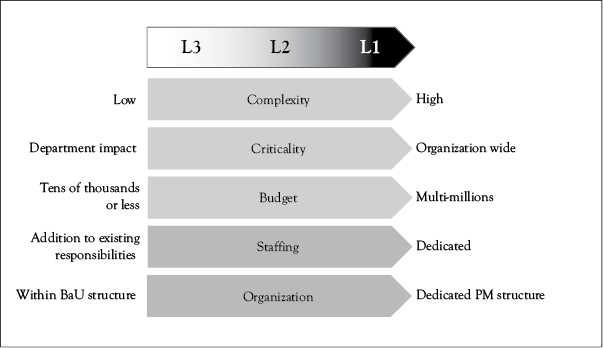Aim of the Book
This is a book about business projects. Projects that aim to change the way business-as-usual (BaU) is done. Projects that happen every day in all industries and functional areas. Medium-important, medium-complex, business change projects. Projects like the one in the previous story,
projects such as relocating facilities, introducing new computer systems, re-engineering departments around processes, or adapting to new regulations.
Pressures on the modern business environment have resulted in lean and very cost-conscious modern organizations. A consequence is these types of medium-important business projects are unable to justify a full-time team. Instead, they are largely staffed by in-house resources working on the project, in addition to their normal responsibilities.
The thesis of the book is that this form of project structure is being used at an increasing rate to meet the demands of rapid business change. However, they are largely unrecognized as a separate organizational category of project, with particular characteristics, management needs, and risks. The consequence is not only project failures, but staff with damaged reputations or who are burned out.
We offer solutions.
It is not an academic tome. It is a practical business book advocating a particular approach for a particular type of project. It is born of observation from the extensive experience of project management practitioners. That experience is as in-house project managers, external project managers, and business consultancy project managers over a period of 30 years across a range of sectors.
Who can benefit from this book? Our target audience is:
- • People who initiate projects.
- • People who sponsor projects.
- • People who lead projects and who want to make the shift from the competent method-driven practitioner to a highly effective stakeholder-focused professional.
The approach advocated by this book is compatible with project methodologies PRINCE2, Association for Project Management (APM), and Project Management Institute (PMI), and also the principles behind Agile. We have largely assumed the reader is familiar with one or more of these standards. The approach described in this book should be used to help tailor your methodology for this specific category of project.
Project Categorization
The project categorization used in this book is shown in Figure 1.1. It distinguishes three types of projects dependent on how they are organized and staffed. This is not a conventional categorization, but one we hope you will recognize and, most importantly, allow us to identify a neglected aspect of managing projects in the modern corporation.

Figure 1.1 Categorizing projects
Source: Images from http://clipart-library.com
The first type are the most complex projects. They are strategic, major cross-company or inter-company (supply chain) business transformations. Examples include major systems introduction such an Enterprise Resource Planning (ERP) system, introduction of just-in-time processes, culture change such as moving the organization to customer focused, or strategic reorientations such as moving major revenue earning to services and away from product sales.
These projects have a full project management structure and are staffed with professional project teams dedicated to the project. We will refer to these as Level 1 strategic projects.
At the other end of the scale, the least business complex projects are conducted within the existing BaU structures. Examples include projects that deliver tactical outputs such a building refurbishment, department information technology (IT) projects, process improvements, and intra-departmental organizational change. The team is almost always drawn from the permanent staff who will lead, manage, and support the project as part of their existing responsibilities. The project will not be of a scale to significantly disrupt their workload or BaU. We will refer to these as Level 3 tactical projects.
There is a remaining category. Projects that are too large a scale and too complex to be run within the BaU structures, but do not warrant a fully dedicated project team. Examples might be large-scale interlinked outputs such as facility relocation, new computer systems, process re-engineering, or cross-company reorganization. To staff these projects, dedicated full-time project resources are supported with business leadership and expertise from the permanent staff. As the staffing is a blend of staff dedicated to the project and staff part-time on the project, we will refer to these as Level 2 projects or composite projects.
In our experience, Level 3 and Level 1 projects are well understood by organizations and, on the whole, managed well, delivering desired outcomes within controlled budget and timescales. However, we regularly see Level 2 composite projects fail to deliver as expected. We believe this is because they are not recognized for what they are and so are not organized and managed optimally. This book is focused on these Level 2 composite projects: how to recognize them, understand common failings of them, and how to best manage them.
Book Structure and Case Studies
This book is written in three parts:
- • Part I describes the evolution of projects and their management as the business landscape has changed.
- • Part II describes the implications of those changes on business and their staff.
- • Part III offers some solutions to reduce those impacts.
To illustrate our points, we have used many case studies drawn from real projects we have worked on. They have been rendered anonymous for two reasons: to meet obligations under non-disclosure agreements and we do not wish to embarrass or offend.
